
Dryas iulia, commonly called the Julia butterfly, Julia heliconian, the flame, or flambeau, is a species of brush-footed butterfly. The sole representative of its genus Dryas, it is native from Brazil to southern Texas and Florida, and in summer can sometimes be found as far north as eastern Nebraska. Over 15 subspecies have been described.

Acraea terpsicore, the tawny coster, is a small, 53–64 millimetres (2.1–2.5 in), leathery-winged butterfly common in grassland and scrub habitats. It belongs to the Nymphalidae or brush-footed butterfly family. It has a weak fluttery flight. It is avoided by most insect predators. This species and the yellow coster are the only two Indian representatives of the predominantly African tribe Acraeini. It is found in India, Sri Lanka, Indonesia, Maldives to Myanmar, Thailand, Laos, Cambodia, Vietnam, Bangladesh, Malaysia, Singapore, and recently Australia.

Manduca rustica, the rustic sphinx, is a moth of the family Sphingidae. The species was first described by Johan Christian Fabricius in 1775.

The western pygmy blue is one of the smallest butterflies in the world and the smallest in North America. It has reached Hawaii, as well as the Persian Gulf, including eastern Saudi Arabia, Bahrain and the United Arab Emirates.

Anaea aidea, the tropical leafwing, is a species of brush-footed butterfly in the subfamily Charaxinae. Its native range extends from Mexico to northwestern Costa Rica, with strays sometimes seen in southern Texas, Arizona, and California in the United States. Some authors consider Anaea aidea to be a subspecies of Anaea troglodyta.
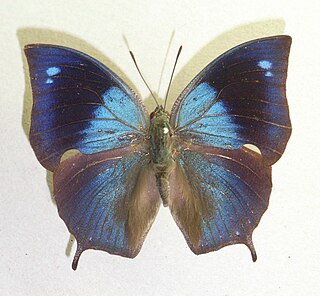
Memphis, described by Jacob Hübner in 1819, is a Neotropical nymphalid butterfly genus in the subfamily Charaxinae.

Battus polydamas, also known as the gold rim swallowtail, the Polydamas swallowtail or the tailless swallowtail, is a species of butterfly in the family Papilionidae. The species was first described by Carl Linnaeus in his 10th edition of Systema Naturae, published in 1758.
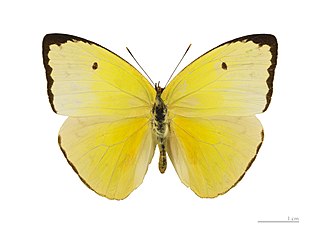
Aphrissa statira, the statira sulphur, is a species of Lepidoptera in the family Pieridae. The species is a medium-sized yellow butterfly, with females more pale than males. They are found from southern regions of Florida and Texas through southern Brazil and northern Argentina. The caterpillars feed on the leaves of several local host plants, while adults prefer to feed on the nectar of red or orange colored flowers. The species is most noted for their dramatic migrations in the tropical areas of the Americas. They have been the subject of many studies about how butterflies navigate and orient during migration.

Catonephele numilia, the blue-frosted banner, blue-frosted Catone, Grecian shoemaker or stoplight Catone, is a butterfly of the family Nymphalidae found in Central and South America.

Papilio andraemon, the Bahaman swallowtail, is a swallowtail butterfly of the subfamily Papilioninae. It is found on the Bahamas, Cuba, Jamaica and the Cayman Islands. It is a rare stray or temporary colonist of the Florida Keys or the mainland near Miami.
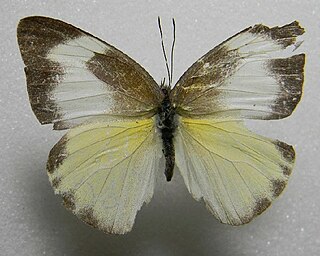
Appias drusilla, the Florida white or tropical white, is a butterfly in the family Pieridae. It is found in tropical America from Brazil north to southern peninsular Florida and the Florida Keys and Antilles. It frequently visits coastal Texas and is a rare stray to Nebraska and Colorado. The habitat consists of tropical lowland evergreen or semideciduous forests.
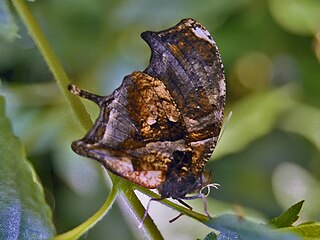
Consul fabius, the tiger leafwing, is the most common and well known species of the genus Consul of subfamily Charaxinae in the brush-footed butterfly family (Nymphalidae). It is found all over the Neotropics.

Hypna is a butterfly genus of the family Nymphalidae. It is monotypic, containing only Hypna clytemnestra, the jazzy leafwing, marbled leafwing or silver-studded leafwing.

Anteos menippe, the great orange tip or orange-tipped angled-sulphur, is a neotropical butterfly of the family Pieridae.
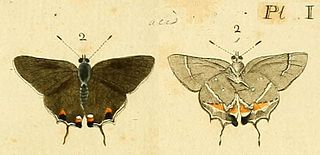
Strymon acis, the Bartram's scrub-hairstreak, is a butterfly of the family Lycaenidae. It is found in southern Florida and the West Indies. The habitat consists of openings in pine woods.

Zaretis itys, the skeletonized leafwing or leaf wing butterfly, is a Neotropical nymphalid butterfly genus in the subfamily Charaxinae.

Anaea are a genus of charaxine butterflies in the brush-footed butterfly family Nymphalidae. The butterflies are commonly known as leafwings. Members of the genus are found throughout the United States, Central America, and the Caribbean.



















